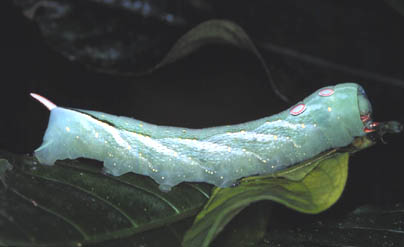LIFE HISTORY
DATA
|
Rearing Results and development
times
|
- As of 1999 N=14 rearings; 10 were parasitized, 2
eclosed, 2 died
- Time as pupa: 18-25 days (N=3).
|
Host plants
|
Rubiaceae:Psychotria chiapensis, P.
hebeclada, Hamelia patens
|
Parasitoids
|
Tachinidae (N=8): Hyphantrophaga sp. (N=2),
Drino sp. (N=1), Belvosia sp. (N=2)
Braconidae (N=2): Cotesia sp.
|
Predators
|
|
Observations and comments
|
- The first and second instars of this species are
green (see photo), changing to either purple or aqua in
the third instar. When they are not feeding, early instar
caterpillars hide in the terminal leaflets of the host
plant while later instars (3rd-5th) hide at the base of
the plant or under a branch. Several of the collections
for this species were made by checking the bases of
damaged plants. Caterpillars often eat half or part of a
leaf, then move to a different leaf to feed. Prepupal
caterpillars change color again and become much more
snake-like. The eyespots become brown filled with black
and the skin becomes brown with a scale pattern.
-
- Although two individuals were parasitized by
Cotesia sp., in both cases the caterpillar died in
the 4th instar and collapsed, failing to hold on to any
substrate and falling into the bottom of the rearing bag.
The wasps exited and attempted to pupate but there were
few survivors. The second caterpillar containing
Cotesia sp. also was parasitized by tachinids.
Both the flies and wasps emerged from the caterpillar but
only flies survived.
|
Voucher location
|
Tulane University
|
